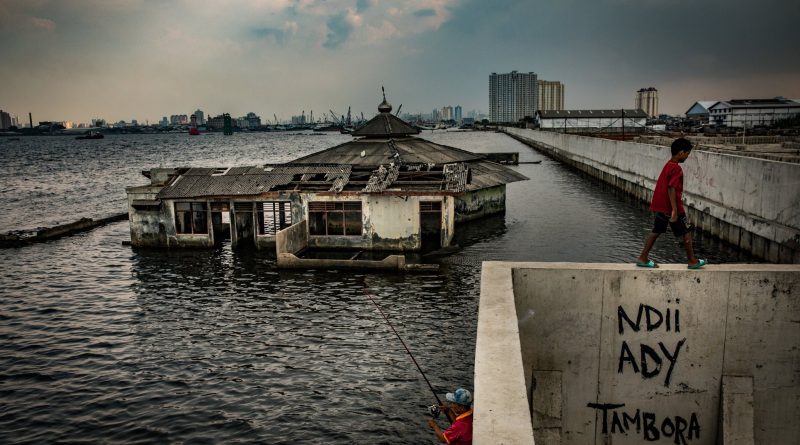NY Times: Jakarta Is Sinking So Fast, It Could End Up Underwater
By Michael Kimmelman
JAKARTA — Rasdiono remembers when the sea was a good distance from his doorstep, down a hill. Back then he opened the cramped, gaily painted bayside shack he named the Blessed Bodega, where he and his family sell catfish heads, spiced eggs and fried chicken.
It was strange, Rasdiono said. Year by year, the water crept closer. The hill gradually disappeared. Now the sea loomed high over the shop, just steps away, held back only by a leaky wall.
With climate change, the Java Sea is rising and weather here is becoming more extreme. Earlier this month another freakish storm briefly turned Jakarta’s streets into rivers and brought this vast area of nearly 30 million residents to a virtual halt.

One local climate researcher, Irvan Pulungan, an adviser to the city’s governor, fears that temperatures may rise several degrees Fahrenheit, and the sea level as much as three feet in the region, over the coming century.
That, alone, spells potential disaster for this teeming metropolis.
But global warming turned out not to be the only culprit behind the historic floods that overran Rasdiono’s bodega and much of the rest of Jakarta in 2007. The problem, it turned out, was that the city itself is sinking.
In fact, Jakarta is sinking faster than any other big city on the planet, faster, even, than climate change is causing the sea to rise — so surreally fast that rivers sometimes flow upstream, ordinary rains regularly swamp neighborhoods and buildings slowly disappear underground, swallowed by the earth. The main cause: Jakartans are digging illegal wells, drip by drip draining the underground aquifers on which the city rests — like deflating a giant cushion underneath it. About 40 percent of Jakarta now lies below sea level.
Coastal districts, like Muara Baru, near the Blessed Bodega, have sunk as much as 14 feet in recent years. Not long ago I drove around northern Jakarta and saw teenagers fishing in the abandoned shell of a half-submerged factory. The banks of a murky canal lapped at the trestle of a railway bridge, which, until recently, had arched high over it.
Climate change acts here as it does elsewhere, exacerbating scores of other ills. And in Jakarta’s case, a tsunami of human-made troubles — runaway development, a near-total lack of planning, next to no sewers and only a limited network of reliable, piped-in drinking water — poses an imminent threat to the city’s survival.
Sinking buildings, sprawl, polluted air and some of the worst traffic jams in the world are symptoms of other deeply rooted troubles. Distrust of government is a national condition. Conflicts between Islamic extremists and secular Indonesians, Muslims and ethnic Chinese have blocked progress, helped bring down reform-minded leaders and complicated everything that happens here, or doesn’t happen, to stop the city from sinking.
“Nobody here believes in the greater good, because there is so much corruption, so much posturing about serving the public when what gets done only serves private interests,” as Sidney Jones, the director of the local Institute for Policy Analysis of Conflict, put it. “There is no trust.”
Hydrologists say the city has only a decade to halt its sinking. If it can’t, northern Jakarta, with its millions of residents, will end up underwater, along with much of the nation’s economy. Eventually, barring wholesale change and an infrastructural revolution, Jakarta won’t be able to build walls high enough to hold back the rivers, canals and the rising Java Sea.
And even then, of course, if it does manage to heal its self-inflicted wounds, it still has to cope with all the mounting threats from climate change.
How It Got So Bad
As far the eye can see, 21st-century Jakarta is a smoggy tangle of freeways and skyscrapers. Spread along the northwestern coast of Java, this capital of the nation with the world’s largest Muslim population used to be a soggy, bug-infested trading port for the Hindu kingdom of Sunda before local sultans took it over in 1527.
They named it Jayakarta, Javanese for victorious city.
Dutch colonists arrived a century later, establishing a base for the East India territories. Imagining a tropical Amsterdam, they laid out streets and canals to try to cope with water pouring in from the south, out of the forests and mountains, where rain falls nearly 300 days out of the year. Thirteen rivers feed into the city.
After independence in 1945, the city began to sprawl. Today, it is virtually impossible to walk around. Parks are rarer than Javan rhinos. A trip to the nearest botanical garden requires the better part of a day in bumper-to-bumper traffic.
“Living here, we don’t have other places to go,” said Yudi and Titi, a young professional couple who one recent Sunday had made the roughly hour’s round trip from western Jakarta to the center of the city just to spend a few minutes walking up and down a chaotic, multilane freeway briefly closed to traffic. “Without cars, at least you can breathe for a few minutes,” Titi said.
The most urgent problems are in North Jakarta, a coastal mash-up of ports, nautically themed high-rises, aged fish markets, abject slums, power plants, giant air-conditioned malls and the congested remnants of the colonial Dutch settlement, with its decrepit squares and streets of crumbling warehouses and dusty museums.
Some of the world’s most polluted canals and rivers weave a spider’s web through the area.
It is where the city is sinking fastest.
That’s because, after decades of reckless growth and negligent leadership, crises have lined up here like dominoes.
Jakartan developers and others illegally dig untold numbers of wells because water is piped to less than half the population at what published reports say are extortionate costs by private companies awarded government concessions.
The aquifers aren’t being replenished, despite heavy rains and the abundance of rivers, because more than 97 percent of Jakarta is now smothered by concrete and asphalt. Open fields that once absorbed rain have been paved over. Shores of mangroves that used to help relieve swollen rivers and canals during monsoons have been overtaken by shantytowns and apartment towers.
There is always tension between immediate needs and long-term plans. It’s a similar story in other sinking giants like Mexico City. Here, all of the construction, combined with the draining of the aquifers, is causing the rock and sediment on which Jakarta rests to pancake.
Construction has skyrocketed as businesses and foreigners have arrived, and also because rural Indonesians have been fleeing the lowlands of Sumatra and Kalimantan, the Indonesian part of Borneo. They have been driven out by coal mines and tobacco farms. The effect on the countryside has been disastrous, with the burning of rain forests to make way for palm oil producers and textile factories causing fires so smoky they have caused air pollution to spike as far away as Malaysia, contributing to climate change.
These factories also dump tons of waste and chemicals into waterways, contaminating the city’s drinking water supply.
And many of the rural poor have settled in Jakarta in informal developments, or kampungs, that cluster along canals, their houses teetering above the water on stilts, the waterways underneath becoming default sewers.
All of these homes, all of this sewage and garbage now jam pumping stations that the city has had to build because gravity no longer drains the rivers and canals naturally.
To halt the sinking, the city needs to stop the digging of wells, which means Jakarta must provide residents with reliable, clean, piped-in water and, to clear the waterways, somehow — at a cost of untold billions — retrofit one of the world’s biggest cities with a sewer system, or something approaching it.
Cleaning the canals and rivers will also require policing the factories that dump chemicals, which means grappling with corruption — and resettling many of the informal communities. But resettlement depends on finding land and then building thousands of new homes for displaced residents, most of whom don’t want to move in the first place.
A Difficult Solution: Evictions
One afternoon I met a man named Topaz in the ruins of an evicted waterfront kampung named Akuarium. A soft-spoken 31-year-old events organizer, Topaz described himself as a third-generation resident of what used to be a thriving informal neighborhood with four-story buildings and bustling streets filled with shops.
That was before the bulldozers arrived. The Akuarium I found had been reduced to mounds of broken masonry and concrete.
“The government said the eviction was about cleaning the river, but I believe it was about politics and development,” Topaz told me, reflecting a belief widely held among residents. He showed me around the tattered, windswept tent he shares with a dozen other squatters not far from where his family home used to be. Over his shoulder, several luxury waterfront apartment towers were under construction. “I saw promotions for those towers that showed Akuarium turned into a park,” Topaz said.
Jakarta’s former governor, Basuki Tjahaja Purnama, known as Ahok, ordered the eviction. He is ethnic Chinese, a geological engineer by training. As governor, he tackled several of Jakarta’s big problems, or tried to. He tried, but failed, to wrest control of the water supply from the private companies. He assembled a sanitation crew, called the Orange Army, to remove sediment and garbage from rivers and canals.
And he cleared out some of the kampungs that obstructed waterways. The efforts began to make a difference. Rains that once caused days of floods drained within hours.
But many people forced out, like Topaz, resisted the moves, convinced that the evictions were really intended to enrich developers, not improve drainage. Akuarium became a hotbed of protest against the governor.
Capitalizing on residents’ resistance and the piety of the urban poor, the hard-line Islamic Defenders Front teamed with some of the governor’s political rivals and religious conservatives to tap into a vein of anti-Chinese populism. Ahok’s enemies escalated what had been a conflict over the displacement of a fishing community into an argument about whether a non-Muslim should lead a Muslim-majority city.
The governor found himself regularly attacked at Friday prayers. He lost his re-election bid, and the Islamists, who exploited anger against him, had him brought up on charges of blasphemy. He is serving two years in prison.
The new governor of Jakarta, Anies Baswedan, who ran a campaign that drew support from Akuarium’s angry residents, announced in November as one of his first acts that he planned to rebuild some of the shelters at the kampung.
At another evicted settlement called Bukit Duri, I met Agus Fadilah, 34, a motorbike-taxi driver, gazing at the rubble of what used to be his house on the banks of the Ciliwung, one of the city’s main rivers. Bulldozers were still moving piles of debris, and a few women were scavenging for family belongings.
Upstream, several other kampungs had already been cleared, the river widened, its banks lined with concrete and surrounded by high concrete walls, now tagged with graffiti. The river there looks imprisoned, but water flows more easily.
“I was raised here, my job was here,” Mr. Agus said, noting that he, his wife and two young children had been relocated to a new apartment building hours away. They make long daily commutes because they want to keep the children in their old schools.
“I know why they did this,” he told me. “It had to do with the river. I know this was not legally our land. But it was my home.”
Residents of Bukit Duri filed a class-action lawsuit against the government to protest the evictions. Recently, a district court judge ruled in their favor.
“It’s not that nobody should move,” argues Elisa Sutanudjaja, a kampung advocate and the executive director at the Rujak Center for Urban Studies. “These poor communities don’t all want to stay in place, but they do want to stay together and near their jobs, and they want legal status.
“Mostly, they want to be consulted,” she said.
They also want to show, where possible, that moving isn’t the only solution. In a leafy kampung called Tongkol, residents during the last couple of years have installed their own septic tanks and kept their stretch of the Ciliwung clean. A young architect named Kamil Muhammad, from Architecture Sans Frontieres-Indonesia, designed a low-cost home made of concrete, bamboo and reused brick. It stacks seven tiny apartments under a covered communal roof deck.
The project is a template for cheap, do-it-yourself housing that can free up space along Jakarta’s waterways critical for flood control.
“We want to demonstrate to the government that kampungs can actually be beneficial to the river,” Kamil told me as we looked over the river from the roof deck. Below, banana and star fruit trees shaded a riverside promenade of colorful facades and vegetable gardens.
JanJaap Brinkman, a hydrologist who for decades has been studying Jakarta for the Dutch water research institute Deltares, sympathizes with residents of communities like Akuarium and Tongkol. Eviction isn’t a cure-all, or even possible, he said, considering how many countless thousands of Jakartans now live atop the canals and rivers in informal developments. At the same time, Mr. Brinkman stressed, moving people is necessary, and bungled evictions squander a meager reservoir of good will and precious time.
“We need big steps now,” he said. “If all the discussions get tied up with fishermen and development, there will eventually be a massive calamity and deaths and no choice but to give up on whole parts of Jakarta.”
Halting Progress
There is occasional talk here about the Indonesian government moving its capital elsewhere, to shrink the city. Politicians issue decrees prohibiting developers from digging wells and imploring residents to store rainwater. Enforcement is negligible.
Mr. Brinkman drove me one morning to the city’s new 16-mile Eastern Flood Channel, its banks lined with parkland. The channel has helped relieve flooding. From there we toured a century-old water gate, also recently repaired. “A few years ago this was solid waste,” Mr. Brinkman said, gesturing across the wide, murky water. On the opposite bank, sanitation crews in bright orange outfits gathered around garbage trucks. They belonged to Ahok’s Orange Army.
“This gate is nothing like it used to be,” Mr. Brinkman said. “You used to be able to walk across the water, it was so clogged with garbage and sediment.”
As he spoke, one of the orange-clad sanitation workers leaned his head back, polished off a bottle of water and tossed the empty plastic container over one shoulder into the river.
Real progress is often thwarted here. The most ambitious move by the city is the construction of what’s called the Coastal Wall, now rising like a black cliff from Jakarta Bay. It’s a quasi-temporary barrier to hold back the rising sea and compensate for subsidence — built extra high because, like the rest of North Jakarta, it is expected to sink, too. With subsidence at the current rate, the Coastal Wall itself may be underwater by 2030.
Even more alarming, Mr. Brinkman showed me one spot along the waterfront where the wall ends and all that holds back the sea is a low, crumbling concrete rampart. The water was only a couple of feet below the top when we peered over the embankment.
“If this wall breaks, there’s simply no holding back the Java Sea,” said Mr. Brinkman, gesturing from the rampart toward the city. “Jakarta will flood all the way to the center of town, six kilometers from here. I could take you to 20 other places just like this.”
The Coastal Wall belongs to a larger project that Indonesian officials undertook three years ago in collaboration with the Dutch government. Called the National Capital Integrated Coastal Development program, it imagines supplementing the Coastal Wall with a second barrier, a Giant Sea Wall, or massive dike, miles out to sea, in effect closing off Jakarta Bay entirely.
The dike would not just block rising waters. According to the original plan, it would also become the spine for an immense new megadistrict and ring road, a $40 billion development — and a windfall for real estate moguls and Dutch consultants — designed in the shape of a garuda, the national bird.
The Great Garuda, as it came to be called, was Jakarta’s Big Idea.
Or it was until just lately.
The government has now backtracked on the megadistrict idea, while still envisioning the dike itself — the very notion of which has provoked understandable skepticism. As environmentalists have pointed out, if the city doesn’t first clean up its rivers and canals, a dike will turn an enclosed Jakarta Bay into the world’s largest cesspool.
The development scheme was also linked to discredited plans for reclaimed islands inside the bay. Delayed for years by recession and legal wrangling, the islands started to get built in 2013, marketed as posh oases of condominiums, yacht marinas and golf courses primarily to customers in places like Malaysia and Singapore.
Enraged fishermen sued, claiming that the islands destroyed their traditional fishing grounds. When one developer was exposed for bribing local officials, a scandal erupted and construction was halted.
At the same time, the islands had become tied up with the Great Garuda. Officials, including Ahok, realized that a tax on the islands’ developers could help Indonesia pay for the giant dike, along with other costly initiatives to clear waterways and stop the sinking.
In essence, a plan that environmentalists and many poor fishermen agreed would wreak environmental havoc on the bay and North Jakarta was being touted by Jakartan leadership as a means to save the city itself — and from climate change.
Ardhasena Sopalheluwakan is among the climate scientists here who think the best approach was never to construct a giant dike but “to give back part of North Jakarta to nature,” as he put it to me one recent morning. The idea would be to “reintroduce mangroves and rejuvenate some of the dozens of reservoirs that were actually part of old Jakarta.”
From Mr. Brinkman’s perspective, just “counteracting subsidence will account for 90 percent of what this city needs to do to deal with climate change.”
Tokyo was in a similar predicament after World War II, he likes to point out. It had sunk about 12 feet since 1900. But the city poured resources into new infrastructure and established stricter rules about development, and within a decade or two made itself a global model of urban innovation, better able to cope with the effects of climate change.
“Jakarta could become a 21st-century version of Tokyo in the 20th century, an example for urban redevelopment,” Irvan Pulungan, the climate change adviser to the city’s new governor, imagined.
But “a city that can’t deliver basic services is a failed city,” he added. ”On top of conventional issues like flooding and urbanization we now have climate change, tipping the scale. And at this rate, people will be fighting in the streets for increasingly limited resources like clean water and safe living spaces.”
Like Tokyo half a century ago, Jakarta is at a turning point, he said: “Nature will no longer wait.”
Source: New York Times
Image Courtesy: New York Times




